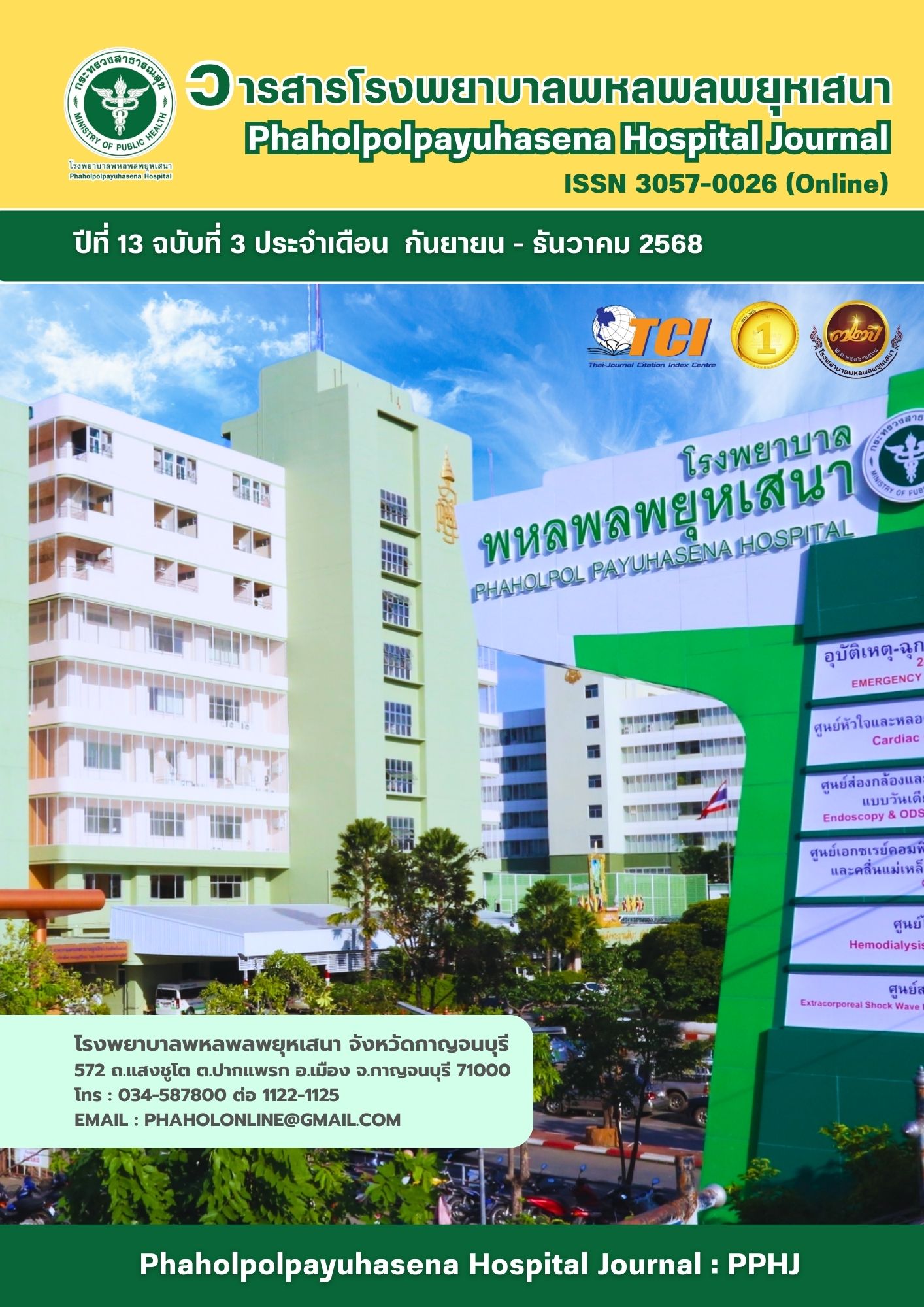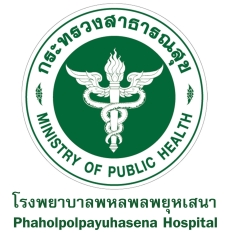Incidence and Factors Associated Among Continuous Ambulatory Peritoneal Patients Undergoing Dialysis with Peritonitis in Hua Hin Hospital, Prachuap Khiri Khan Province
Keywords:
Continuous ambulatory peritoneal dialysis, Peritonitis, End-stage renal diseaseAbstract
Objectives: To study the incidence and risk factors associated with peritonitis in patients with end-stage renal disease (ESRD) undergoing continuous ambulatory peritoneal dialysis (CAPD) at Hua Hin Hospital, Prachuap Khiri Khan Province.
Methods: A retrospective cohort study was conducted, reviewing the medical records of 124 patients with ESRD undergoing CAPD at Hua Hin Hospital from 2019 to 2024. Peritonitis was diagnosed according to the criteria of the International Society for Peritoneal Dialysis (ISPD) 2022. Data was analyzed using descriptive statistics, the Chi-square test, the independent t-test, and multiple logistic regression analysis.
Results: A total of 74 patients (59.7%) developed peritonitis, accounting for 177 episodes, which yields an incidence of 0.24 episodes per patient-year. Most cultures showed no growth (37.8%), and the most common isolated microorganism was Staphylococcus aureus (18.9%). Most treatments resulted in a good response (61.0%), followed by a relapse (repeat infection with the same organism within 4 weeks) (13.0%). Significant risk factors for peritonitis were: diabetes mellitus (aOR=2.10; 95% CI: 1.15−3.85), serum albumin level (aOR=0.75; 95% CI: 0.69−0.87), hemoglobin level (aOR=0.88; 95% CI: 0.79−0.98), serum potassium level (aOR=0.92; 95% CI: 0.85−0.99), and serum phosphorus level (aOR=1.30; 95% CI: 1.02−1.65)
Conclusions: Peritonitis remains a major complication in PD patients, with Gram-positive organisms being the main causative agents. Timely diagnosis and treatment, along with the management of associated risk factors, are crucial for prognosis. Prevention strategies should include close patient monitoring, nutritional support, and strict adherence to aseptic techniques.
References
Global, regional, and national burden of chronic kidney disease, 1990-2017: a systematic analysis for the Global Burden of Disease Study 2017. Lancet. 2020;395(10225):709-33.
นฤมล แก่นสาร. การพยาบาลผู้ป่วยไตเรื้อรังระยะสุดท้ายที่ได้รับการล้างไตทางช่องท้องแบบต่อเนื่องที่มีการติดเชื้อของเยื่อบุช่องท้อง: กรณีศึกษา 2 ราย. วารสารโรงพยาบาลมหาสารคาม. 2558;12(2):81-91.
Thaiyuenwong J, Mahatanan N, Jiravaranun S, Boonyakarn A, Rodpai S, Eiam-Ong S, et al. Nationwide peritoneal dialysis nurse training in Thailand: 3-year experience. J Med Assoc Thai. 2011;94 Suppl 4:S162-6.
Nakamoto H, Kawaguchi Y, Suzuki H. Is technique survival on peritoneal dialysis better in Japan. Perit Dial Int. 2006;26(2):136-43.
Li PK, Chow KM, Cho Y, Fan S, Figueiredo AE, Harris T, et al. ISPD peritonitis guideline recommendations: 2022 update on prevention and treatment. Perit Dial Int. 2022;42(2):110-53.
สิริรัตน์ อัศวเมธาพันธ์. อุบัติการณ์และลักษณะทางคลินิกของผู้ป่วยล้างไตทางหน้าท้อง ในผู้ป่วยไตวายเรื้อรัง ระยะสุดท้าย ในโรงพยาบาลศรีสะเกษ ระหว่าง ปี พ.ศ. 2561-2563. วารสารสำนักงานสาธารณสุขจังหวัดขอนแก่น. 2564;3(2):207-20.
รัชนี เชี่ยวชาญธนกิจ. เชื้อก่อโรคกับผลลัพธ์จากการติดเชื้อช่องท้องอักเสบของการล้างไตทางช่องท้องในหน่วยไตเทียม โรงพยาบาลสวรรค์ประชารักษ์. วารสารวิชาการแพทย์และสาธารณสุข เขตสุขภาพที่ 3. 2563;17(3):82-93.
Hill NR, Fatoba ST, Oke JL, Hirst JA, O'Callaghan CA, Lasserson DS, et al. Global Prevalence of Chronic Kidney Disease - A Systematic Review and Meta-Analysis. PLoS One. 2016;11(7):e0158765.
Al Sahlawi M, Zhao J, McCullough K, Fuller DS, Boudville N, Ito Y, et al. Variation in Peritoneal Dialysis-Related Peritonitis Outcomes in the Peritoneal Dialysis Outcomes and Practice Patterns Study (PDOPPS). Am J Kidney Dis. 2022;79(1):45-55.e1.
Ueda R, Nakao M, Maruyama Y, Nakashima A, Yamamoto I, Matsuo N, et al. Effect of diabetes on incidence of peritoneal dialysis-associated peritonitis. PLoS One. 2019;14(12):e0225316.
อรรถพร พัชรสุวกุล. การติดเชื้อที่เยื่อบุผนังช่องท้องในผู้ป่วยที่ได้รับการล้างไตทางช่องท้องอย่างต่อเนื่อง ในโรงพยาบาลพระจอมเกล้า จังหวัดเพชรบุรี. วารสารแพทย์เขต 4-5. 2557;33(1):9-14.
ธิติมา สายสุด. อุบัติการณ์การติดเชื้อและปัจจัยเสี่ยงของการติดเชื้อช่องท้องอักเสบในผู้ป่วยล้างไตทางช่องท้องโรงพยาบาลสมเด็จพระยุพราชเดชอุดม. วารสารวิจัยและพัฒนานวัตกรรมทางสุขภาพ. 2566;4(3):126-34.
ณรงค์ชัย สังซา. ปัจจัยที่มีความสัมพันธ์ต่อการติดเชื้อแบคทีเรียในช่องท้องของผู้ป่วยโรคไตวายเรื้อรังที่ได้รับการล้างไตทางช่องท้อง. วารสารโรงพยาบาลมหาสารคาม. 2561;15(2):44-56.
Makruasi S, Khuancharee K, Makruasi N. Risk Factors Associated with Outcomes of Continuous Ambulatory Peritoneal Dialysis Survival: A Single-Center Study in A General Hospital. Asian Medical Journal and Alternative Medicine. 2021;21(3):254-61.
เฉลิมพล ณ เพ็ชรวิจารณ์. ระบาดวิทยาของการติดเชื้อแบคทีเรียในเยื่อบุช่องท้อง ในผู้ป่วยล้างไตทางช่องท้องอย่างต่อเนื่อง โรงพยาบาลมหาราชนครศรีธรรมราช. มหาราชนครศรีธรรมราชเวชสาร. 2563;4(1):84-96.
ลัดดาพร วงษ์ลือชัย, จิรยุพา แผ่วพลสง, ปัจจัยที่ส่งผลอัตราการเสียชีวิตและภาวะแทรกซ้อนในผู้ป่วย ที่ได้รับการล้างไตทางช่องท้องที่มีภาวะโพแทสเซียมในเลือดต่ำ. วารสารสมาคมโรคไตแห่งประเทศไทย. 2564;27(4):66-74.
Dong J, Chen Y. Impact of the bag exchange procedure on risk of peritonitis. Perit Dial Int. 2010;30(4):440-7.
กุลกันยา ลิมปกรณ์กุล. การศึกษาภาวะโพแทสเซียมต่ำเป็นปัจจัยเสี่ยงต่อการติดเชื้อเยื่อบุผนังช่องท้องในผู้ป่วยล้างไตทางช่องท้อง. วารสารสิ่งแวดล้อมศึกษาการแพทย์และสุขภาพ. 2558;10(2):370-7.
Downloads
Published
How to Cite
Issue
Section
License
Copyright (c) 2025 Phaholpolpayuhasena Hospital

This work is licensed under a Creative Commons Attribution-NonCommercial-NoDerivatives 4.0 International License.
บทความที่ได้รับการตีพิมพ์เป็นลิขสิทธิ์ของโรงพยาบาลพหลพลพยุหเสนา
ข้อความที่ปรากฏในบทความแต่ละเรื่องในวารสารวิชาการเล่มนี้เป็นความคิดเห็นส่วนตัวของผู้เขียนแต่ละท่านไม่เกี่ยวข้องกับโรงพยาบาลพหลพลพยุหเสนาและบุคลากรท่านอื่น ๆ ในโรงพยาบาลฯ แต่อย่างใด ความรับผิดชอบองค์ประกอบทั้งหมดของบทความแต่ละเรื่องเป็นของผู้เขียนแต่ละท่าน หากมีความผิดพลาดใด ๆ ผู้เขียนแต่ละท่านจะรับผิดชอบบทความของตนเอง



 Phaholpolpayuhasena Hospital
Phaholpolpayuhasena Hospital
